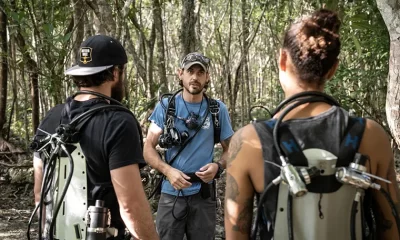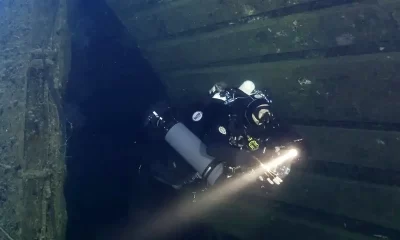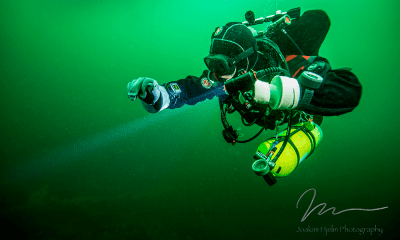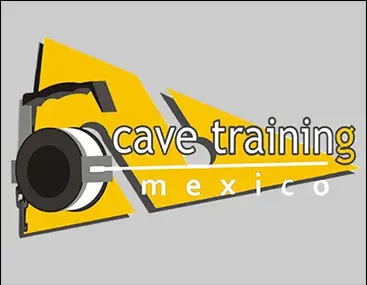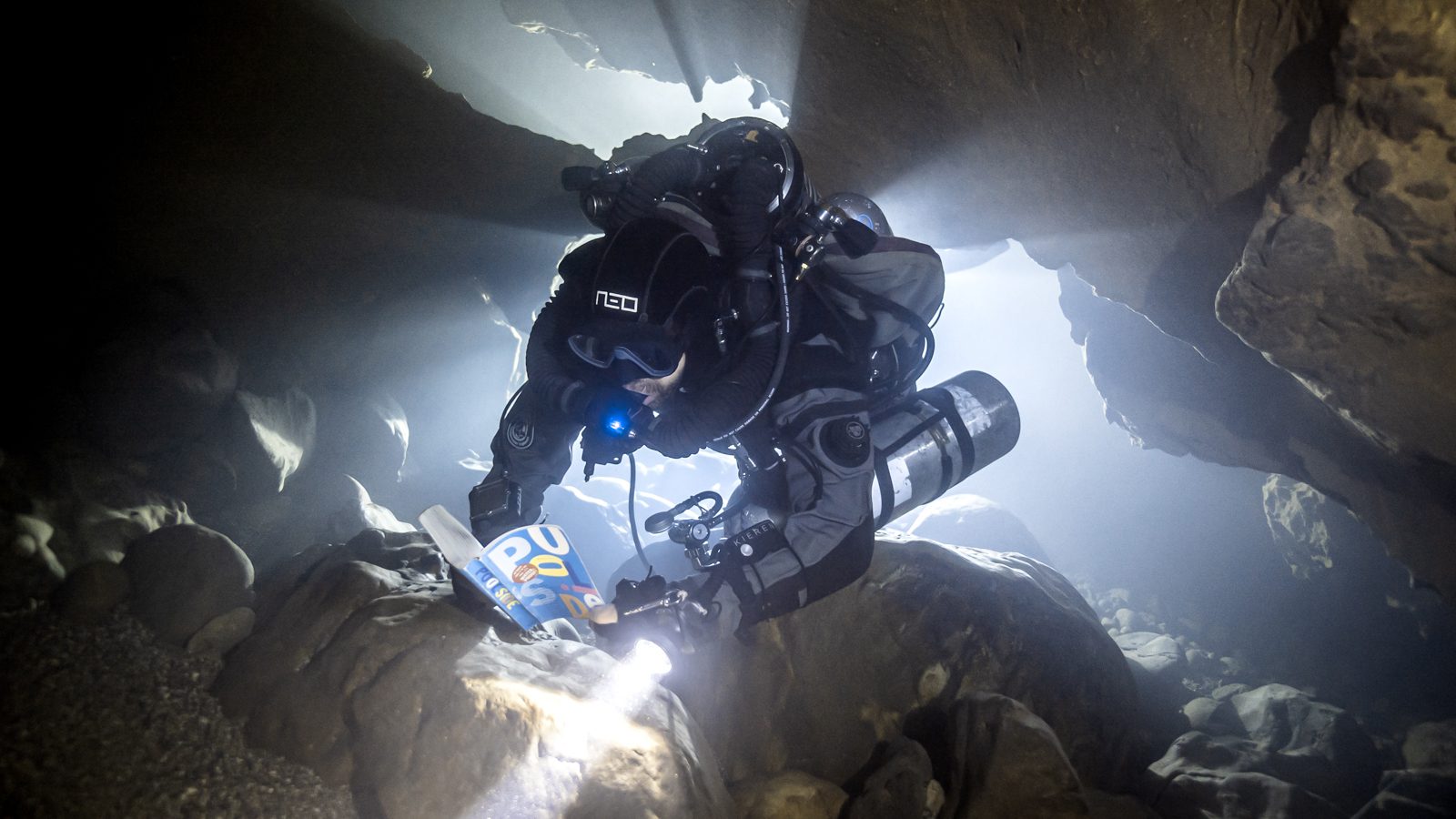
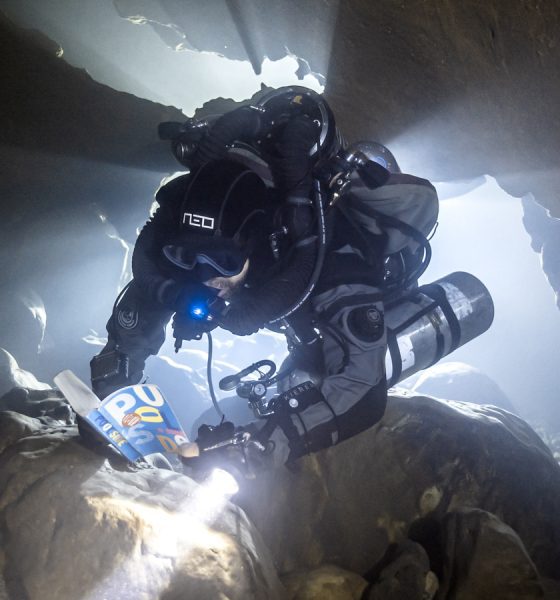
Education
How Deep Is Your Library?
Tech diving requires a deep body of knowledge that must be kept current. So it seemed appropriate to ask, what books should tekkies have on their shelves? To answer that question we turned to DAN’s nerdy risk mitigation coordinator cum cave diver, Christine Tamburri to suss out suitable tekkie tomes. Here is what she uncovered. Feed your head!
by Christine Tamburri. Header image: Jon Kieren catching up on his reading at Sistema Huautla by SJ Alice Bennett. Ed. note-Special thanks to Jason Brown for suggesting the topic.
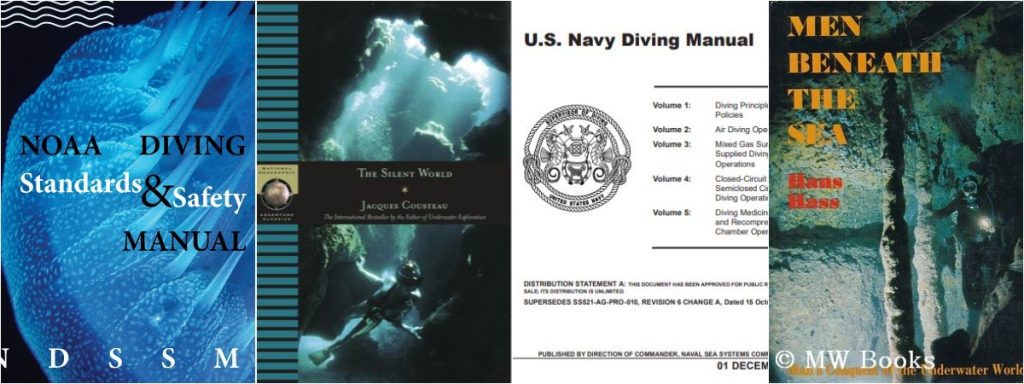
The hallmark of a “super nerd” is typically the extent of their library. For row after row, their bookshelves overflow with everything from fiction to mystery to fantasy. Variety is the secret weapon. Deep down, tekkies are also super nerds with a diving addiction so, naturally, their bookshelves should also be overflowing with nerdy scuba works. Some books are a given, like the U.S. Navy Manual (First Edition – 1905), the NOAA Diving Manual (First Edition – 1975), The Silent World by Frédéric Dumas and Jacques Cousteau (1953), and Men Beneath the Sea by Hans Hass (1975). Others are not so obvious.
After countless conversations extending into the far reaches of the night with some of the industry greats, it became obvious that only a few books were well-known by divers around the world. Several were long forgotten or never discovered in the first place, and thanks to the input of Michael Menduno, Frauke Tillmans, Roger Williams, and Ken Sallot, this comprehensive list stands ready to help every tekkie become a super nerd. Even Rick Stanton himself crashed a virtual book club meeting to give his input on which books are most captivating.
You are invited to take a deep dive (pun intended) into an extensive list of works that all tekkies should have on their bookshelves. Of course, hours upon hours could be spent discussing book after excellent book pertaining to the Andrea Doria, Wookey Hole, the Britannic, Great Lakes shipwrecks, such as Richie Kohler’s Mystery of the Last Olympian: Titanic’s Tragic Sister Britannic etc, but there is simply not enough time in the day or room on the page. As such, this list is not all-encompassing, but it is a solid foundation. A starter set of books if you will.
Classics from Early Tech

Some books age like fine wine. The longer they sit on the bookshelf, the more iconic they become. Some of these works are highly sought after and rarely available, but all are a time capsule of an iconic period in dive history. Taking things back to the early pre-scuba skin diving days,
Last of the Blue Water Hunters by Carlos Eyles (First Edition – 1985) is an epic recount of early breath-hold divers who ventured out into blue water in search of game, and in doing so, defied ancient myths and fears, and tested themselves in the process. It speaks to books like Shadow Divers by Robert Kurson (2004) and The Last Dive by Bernie Chowdhury (2000) document important times in the progression of wreck diving. They are often referred to as a “gateway drug” for those considering the leap into technical diving. Ultimate Wreck Diving Guide by Gary Gentile (1992) takes things a step further by detailing all aspects of wreck diving and how technology has thrust it into the mainstream.
A tekkie library would not be complete without a collection dedicated to the origins of the quest to go deeper for longer. Before founding TDI in 1994, Bret Gilliam wrote two books. Deep Diving by Bret Gilliam and Robert Von Maier with John Crea and Darren Webb (1992) discusses the transition from the recreational realm into the technical world, while Mixed Gas Diving by Tom Mount and Bret Gilliam (1992) discusses almost everything that divers need to know before venturing into the world of obscure breathing gas mixes.

Some years later, Doing it Right: The Fundamentals of Better Diving by Jarrod Jablonski (2000) was published as a guideline for the gear configuration and training philosophies of Global Underwater Explorers (GUE). This work was updated in 2021 and the title was shortened to The Fundamentals of Better Diving.
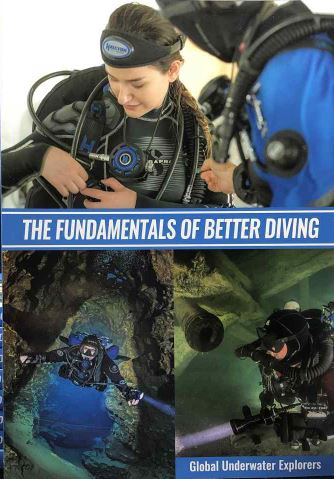
Another classic published by a seriously busy pioneer in the industry is Technical Diving from the Bottom Up by Kevin Gurr (2004). Somewhere between building some of the first mixed gas computers and three different rebreather models (Ourobouros, Sentinel, and Explorer), Gurr found time to dive deep into technical diving while covering gear configurations, physiology, gas mixes, and a variety of other topics. Of course, this category wouldn’t be complete without mentioning a work that is defined by the word “classic”…aquaCORPS Journal by Michael Menduno (First Edition – 1990)! First introduced at DEMA in 1990, aquaCORPS revolutionized the technical diving world, uniting tekkies far and wide as they discussed topics that were seen by those not in the know as being incomprehensible. It was quickly followed by Joel Silverstein’s SUB AQUA Journal (1991), Curt Bowen’s Deep Tech (1995), and Bernie Chowdhury’s Immersed (1995), which was later purchased by Diver magazine.

Got Your Meds?
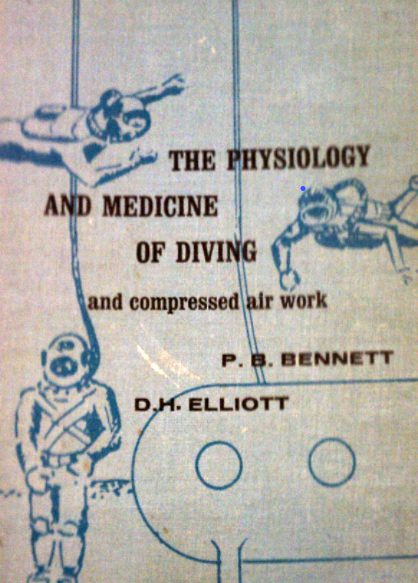
Diving is one of the few sports that changes the physiological characteristics of the body. The changes that occur upon immersion are not simple to understand, so a true tekkie will add a few diving medicine books to their shelves. Physiology and Medicine of Diving by Peter Bennett and David Elliot (First Edition – 1969) and Diving Medicine by Alfred Bove and Jefferson Davis (First Edition – 1976) are seen as “bibles” to some physicians. These works would be carried around conferences with pride, as notes were feverishly taken and sections were enthusiastically highlighted. Even Jim Bowden would read Physiology and Medicine of Diving every day as he was preparing for his attempt to dive to the bottom of Zacatón. Very few will read these cover-to-cover, but their value as reference materials is unmatched, and they are a must-have to complete any tekkie library.
As an aside, a legend was recently lost as Professor David Elliot passed away on January 18, 2022. His legacy in dive medicine will continue to live on through his published materials.
Gasses Galore

Nitrogen, oxygen, helium, argon, hydrogen…without them, the periodic table would be incomplete, and tekkies wouldn’t be able to satisfy their ever-present urge to submerge. In fact, these gasses are so important that they deserve a category of their own! Vance Harlow is responsible for one of the most sought-after gas mixing books ever written. Oxygen Hacker’s Companion by Vance Harlow (Fourth Edition – 2002) not only details how to mix nitrox and trimix, but it also dives deep into the dangers of handling oxygen and how to mitigate the risks. Many gas blenders agree that a shrine should be built to preserve the wonders of this book forever. The book is currently out of print, however, PDF copies do exist. Seek and ye shall find!
Once gas is mixed, accurate sensors must be used and thanks to Oxygen Measurement for Divers by John Lamb (First Edition – 2016), tekkies can learn more than they ever thought possible about the history, construction, and application of oxygen sensors. This is a must-read, especially for the rebreather divers out there. For those interested in the devastating effects of oxygen toxicity, the classic
Oxygen and the Diver by Kenneth Donald (1992) should be acquired and added to their bookshelf. This historically unique work is solely dedicated to the effects of oxygen on the diver, and it details studies that would definitely be shot down by Internal Review Boards if they were presented today.
The D-Word
Decompression and the corresponding theory are the foundation of technical diving. Decompression: Decompression Sickness by Albert Bühlmann (1983) was published during the midst of extensive research to understand how and why decompression sickness manifests. Basic Decompression: Theory and Application by Bruce Wienke (First Edition – 1991) is another comprehensive work that dives into the theory of decompression and covers topics such as modeling and diving at altitude. Wienke’s work forms the basis of NAUITEC’s decompression protocols and algorithm. Both of these books are integral to tekkie bookshelves as they are classic examples of the early days of decompression research, and they provide insight into how far the industry has progressed. Warning: There is heady math in both of these texts. Get ready to channel your inner Isaac Newton.
Deeper into Diving by John Lippmann (First Edition – 1990) is another early work that focuses on the various decompression tables. Included are the U.S. Navy, Bassett, NH-L, DCIEM, and RNPL/BS tables, just to name a few. A more recent work is Deco for Divers by Mark Powell (2008). This extensive book has it all, from medicine and physiology to modern day decompression procedures, and it is a must-have for anyone even half considering the leap into technical diving. Tekkies new and experienced will learn more than their brain can hold.

Of course, tekkies cannot talk about decompression without mentioning decompression sickness…or “The Bends”, the “Rapture of the Deep”, “Satan’s Disease” or whatever nickname sounds best. Between the Devil and the Deep by Mark Cowan and Martin Robson (2021) is available in Europe now and set to hit US bookshelves shortly and promises to deliver an inside look into what it is like to battle and fight through a DCS hit at depth.
Deeper and Longer
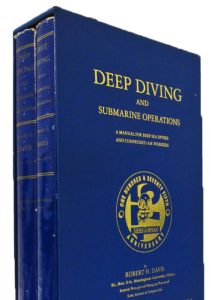
Whether it be climbing Mount Everest or descending into the depths of the Mariana Trench, humans have always been on a quest to push the extremes. For tekkies, the quest has revolved around the ability to go deeper for longer. At the forefront of undersea apparatus development was Sir Robert Davis, a well-respected inventor and businessman who wrote several works, including multiple volumes of Deep Diving and Submarine Operations (Fourth Edition – 1935). This book details the secrets of working at depth, such as compressed air operations, dive tables, and emergency procedures. A complete tekkie library needs to include the most classic of classics, and this certainly falls into that category.
A more obscure and difficult book to find is Arne Zetterström and the First Hydrox Dives by Anders Lindén (1985). As the not-so-subtle name suggests, this work is about two things…. Arne Zetterström and his adventures using hydrox (hydrogen and oxygen) to push the limits! This interesting gas mix is not a thing of the past, but an innovation for the future. With the helium shortage, hydrogen may be the solution for über-deep dives, and this is a must-read for the futuristic tekkie who wants to learn more about where technical diving may progress in the coming years.
In lieu of hydrogen, an alternative solution to the helium conundrum may be atmospheric diving suits (ADS), aka exosuits that are currently being developed by Nuytco Research, Vancouver, Canada. The history of these unique devices can be read about in Ironsuit by Gary Harris (1994). [Ed.note—Watch this space. InDepth is planning a feature story on the state of the ADS nation in a coming issue. Is there an Exosuit in your future? Find out.] Of course, old fashioned helium tends to do the trick most of the time, and tekkies can read all about one woman’s quest to become the deepest in Fatally Flawed by Verna van Schaik (2010).

A final ode to the depths that should rest on all tekkie library shelves is Living and Working in the Sea by James Miller and Ian Koblick (1995). This book encompasses all things saturation diving, from the complete system to the operations to the science. Tekkies may understand the basics of how saturation systems function, but this work will kickstart learning and highlight how physiology, science, and industry combine to make seafloor operations possible.
Notes from the Underground
Cave diving is not a sport of the modern day. In fact, the first known “cave dives” took place in the 1800s and early explorers used freediving techniques or surface-supplied air to wander into the underwater, underground world. Since then, pioneers of the sport have come and gone, and techniques have developed and been modified through time. A true tekkie will revere cave diving to the level that it so rightfully deserves, and a section of their library will be solely dedicated to this quirky subsect of technical diving.
Starting things off with a history lesson, The Darkness Beckons by Martyn Farr (1980) details the history of cave diving around the world. Included are details about exploration projects at Wookey Hole (UK) and Pozo Azul (Spain), as well as recounts about record-setting dives by pioneers of the sport. A complimentary book is A Glimmering in Darkness by Graham Balcombe (2007) which discusses the origin of the Cave Diving Group (CDG) and how cave diving was a natural transition for British dry cavers on their quest to explore sump systems around Europe.

Exploration and caves go together like helium and an empty bank account. Drawn to the Deep: The Remarkable Underwater Explorations of Wes Skiles by Julie Hauserman (2018) and
The Wakulla Springs Project by William Stone (1989) discuss exploration efforts that significantly impacted the cave diving world and shed a positive light on the sport. On the flip side, Beyond the Deep by Barbara Anne Am Ende, Monte Paulsen, and William Stone (2002) is a recount of a dark time in the sport when a deep cave exploration project at Sistema Huautla in Oaxaca, Mexico turned deadly. Super nerds will find interest in all of these works regardless of whether the ending was joyous or tragic.
His Sheckness
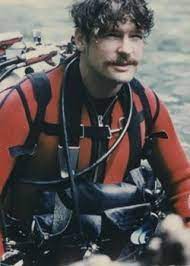
Sheck Exley is often referred to as the greatest cave diver to ever live, and not without strong merits to back the claim. He was the first person to log 1000 cave dives, he was responsible for developing the fundamental rules of cave diving, and he was an explorer who mapped countless caves in North Florida. A legend was lost on April 6, 1994, when Sheck died while trying to find the bottom of Zacatón in Northeast Mexico. Luckily for us, he left behind several works that are still considered gospel by cave divers around the world.
One of the most iconic cave diving books ever written is Basic Cave Diving: A Blueprint for Survival by Sheck Exley (First Edition – 1979). Almost every cave diver was instructed to read this book early in their training, as it gave them an in-depth look at the five basic rules of cave diving: Training, Guideline, Air, Depth, Lights. This work did go further and cover everything from anti-silting techniques to procedures for handling a “berserk diver,” but the five rules are the main takeaway for most readers. This is a staple for any tekkie library, and it is quite literally the foundation on which modern day cave diving is built.
Sheck also wrote a few memoirs where he talked about his life, his initial training, the early days of cave exploration, and the birth of cave diving techniques and philosophies.
Caverns Measureless to Man by Sheck Exley (1994) is iconic, but difficult to find, even in the used book market. It details cave diving through the eyes of Sheck, and it tells the story of those that lost their lives on a quest to explore the underground world. Taming of the Slough by Sheck Exley (published posthumously in 2004) is slightly more specific in that it recounts the exploration at Peacock Springs. This immense cave system is an unofficial rite of passage for Florida cave divers, as its history is as vast as its passages. A tekkie library wouldn’t be complete without a section solely dedicated to the life and accomplishments of one of the greats, and only a true super nerd would dare to track down every book ever written by the legendary Sheck Exley.
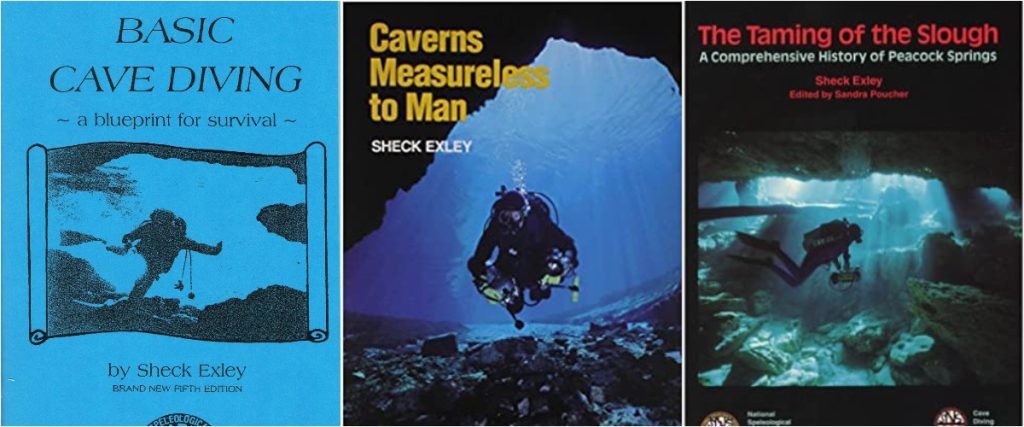
In The Loop
As more and more people dive into the world of rebreathers , it would be unfair to exclude two books written about this futuristic, bubble-less world. Amongst the countless accomplishments of Jeff Bozanic, he wrote one of the most comprehensive rebreather books available. Mastering Rebreathers by Jeff Bozanic (2002) dives deep into topics like the types of rebreathers that are available, the long-term maintenance requirements, emergency procedures, and travel considerations. Similarly, The Basics of Rebreather Diving by Jill Heinerth (2013) discusses the history of rebreather diving, while providing real-life stories of its applications in her own diving career. {Ed.note: And there is always InDepth’s “Holiday Rebreather Shopping Guide,” to view rebreathers on the market and compare their speeds and feeds, err, specs.
Safety First

All divers, especially tekkies, should be constantly learning. Whether in the water or in the library, there is always something new to discuss, practice, and understand. On that same note, every diver is also susceptible to human error, and the lessons learned from near-miss and fatal events are valuable learning tools. Under Pressure by Gareth Lock (2019) is a collection of thoughts and discussions on how human factors play a role in incidents and accidents. It also summarizes the importance of creating a “just culture’” in the dive community so that adverse events can be analyzed without judgment.
Part of this culture is creating a safe space for divers to admit their mistakes. Close Calls by Stratis Kas (2020) is a collection of harrowing stories by some of the biggest names in the dive industry as they recount an incident or series of events that nearly resulted in their injury or death. If you are a super nerd with a hectic life that doesn’t have time to read an entire book cover-to-cover in one sitting, fear not! Each story in this book will only take 5-10 minutes to read, so there is no excuse to not add this work to your tekkie library.
Another book of great value to the safety-conscious super nerd is The Six Skills and Other Discussions by Steve Lewis (2011). This book will discuss all the topics that are left out of textbooks. There is never anything wrong with bookshelves that are overflowing with materials that are focused on safety, because a super nerd is always learning.
Get Off My Back
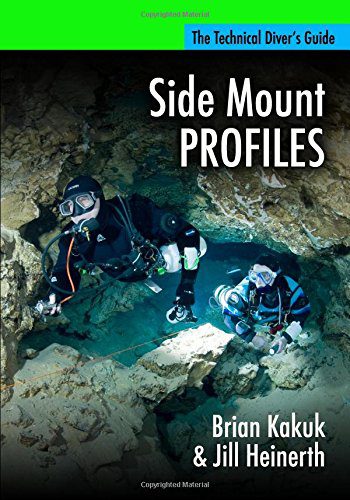
Sidemount, seen by some as our savior from above and seen by others as the unnecessary red-headed stepchild. Regardless of how it is viewed, sidemount is an important component of the modern dive industry, so not surprisingly, there are several books dedicated to the craft. One of the earlier books written solely about this configuration is Sidemount Profiles by Brian Kakuk and Jill Heinerth (2010). For something a little more recent, a tekkie may prefer to dive into Sidemount Diving: The Almost Comprehensive Guide by Rob Neto (Second Edition – 2020). It is no secret that sidemount is finicky and requires patience to perfect. Having access to solid reference materials can make this process slightly more enjoyable, but let’s be honest—you aren’t really a sidemount diver until you’ve spent hours upon hours making minor tweak after minor tweak into the early hours of the morning.
Young Guns

There are several books that are new to the game, but not late to the party. These books aren’t written for the youth in the industry, nor were they written by newcomers. Simply put, they were recently published and quickly sailed to the top of the charts, as they are masterpieces printed in black and white. Starting out strong with an author who is highly influential to women in diving and those seeking to get involved in exploration projects, Jill Heinerth’s autobiography is a compelling tale about her life as a cave diver. Into the Planet by Jill Heinerth (2019) should be in every tekkie library regardless of gender, because the lessons learned and the stories portrayed are captivating and inspiring to all.
In terms of recent events, few will compare to that of the 2018 Thailand cave rescue. If for some reason you haven’t heard about this, it will be assumed that you are living under a rock. To summarize, 12 young boys and their soccer coach were trapped in a flooded cave for 18 days and were miraculously rescued by a team of cave divers. Several books were written about the event from the perspective of some of the divers. The Aquanaut by Rick Stanton and Karen Dealy (2021), Against All Odds by Richard “Harry” Harris and Craig Challen (2019), and Thirteen Lessons that Saved Thirteen Lives by John Volanthen (2021). All of these books retell the harrowing tale of how a group of weekend warriors happened to have the right skill set for the job because of their obscure hobby. They detail the rollercoaster of emotions that were endured and the tough decisions that were made. Every tekkie, regardless of their level of interest in cave diving, will find enjoyment, exhilaration, and inspiration in the pages of these books.
Something Fun

As mentioned early on, variety is the secret weapon to creating a solid tekkie library. Almost every work that has been discussed thus far is semi-serious in nature, so it is time to add a little fun into the mix! Dining with Divers: Tales from the Kitchen Table by David Strike and Simon Pridmore (2017) is a compilation of short stories from legends in the dive industry that conclude with their favorite home-cooked recipe. This is certainly a quirky book, but nonetheless unique. Moving on to fiction, the Mer Cavallo Mystery Series by Micki Browning is written by a diver for divers. Adrift (2017) and Beached (2018) will take readers on a rollercoaster ride that is filled with ghostly tales of the Spiegel Grove and Spanish galleon treasure. For the tekkie with diversified interests, The Jason Parker Trilogy by Dr. John Clarke has it all: undersea habitats, deep sea hydreliox diving, aliens, and even romance! All tekkies should grab a copy of Middle Waters (2014), Triangle (2017), and Atmosphere (2019), and experience the writing of a Navy diving and aviation scientist.
A more extensive collection of novels is the Mike Scott Thriller Series by Eric Douglas. Readers will be taken from Cayman to Hollywood to Mexico as they follow Mike Scott on his diving adventures around the world. Of course, nothing ever goes to plan, so buckle up for yet another rollercoaster ride of events. The super nerds out there will be sure to stock their bookshelves with all 11 books: Cayman Cowboys (2005), Flooding Hollywood (2006), Guardians’ Keep (2008), Wreck of the Huron (2012), Heart of the Maya (2014), Return to Cayman (2015), Oil and Water (2016), The 3rd Key (2017), Turks and Chaos (2017), Water Crisis (2018), and Held Hostage (2021).
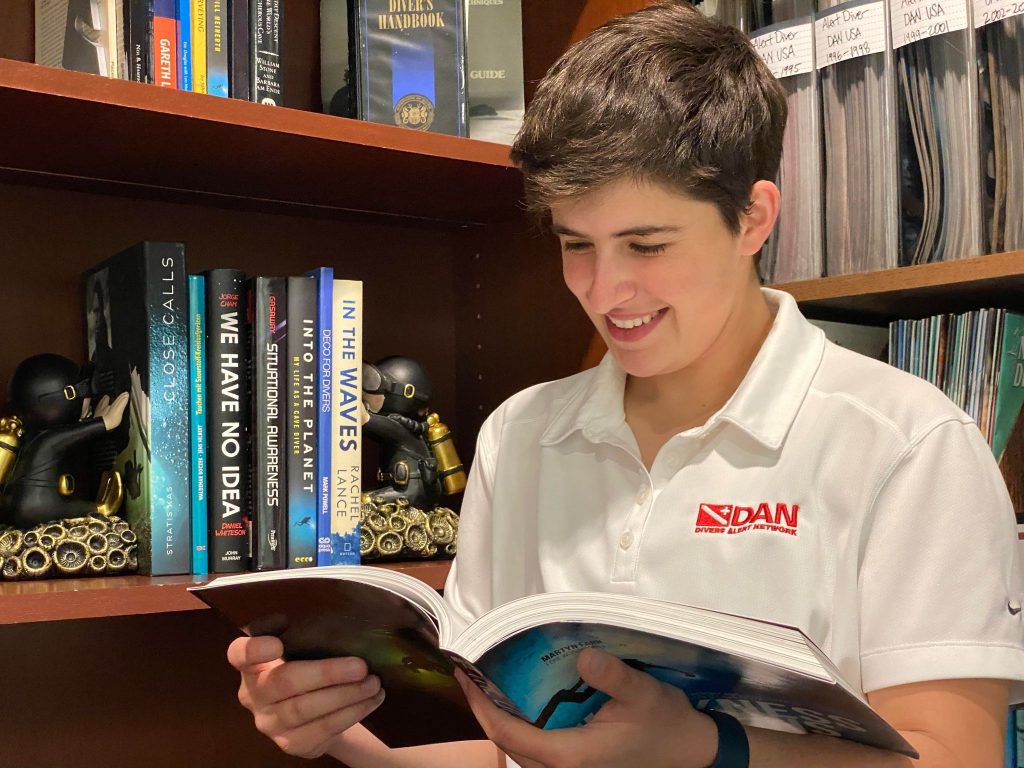
For SUPER Super Nerds Only
This final section deserves a disclaimer…super nerdiness lies ahead. There are a number of forums and discussions that have been held over the years that covered topics from deep sea diving to rebreathers and everything in between. All of these were presented in-person, but luckily, über passionate people exist and they took the initiative to publish everything that was discussed. A tekkie should have a proceeding or two on their bookshelf, and although there are a lot to choose from, a few stand out from the rest. A true super nerd will acquire them all.
For those wanting to learn more about deep diving and the techniques required to do it safely, Hydrogen as a Diving Gas Proceedings of the 33rd UHMS Workshop, Wilmington, NC (February 1987), Proceedings of Advanced Scientific Diving Workshop, Smithsonian Institution, Washington, DC (February 2006), Technical Diving Conference Proceedings, DAN, Durham, NC (January 2008), and Techniques for Diving Deeper than 1,500 Feet, UHMS, Bethesda, MD (March 1980) may be of interest.
If bubbleless diving is more your speed, Proceedings of Rebreather Forum 2.0, Diving Science and Technology, Redondo Beach, CA (September 1996) and Rebreather Forum 3.0 Proceedings, AAUS/DAN/PADI, Orlando, FL (May 2012) should definitely be added to the library. And lastly, for super super nerds with an interest in flying after diving or the nerdy science behind dive computers, the Flying After Recreational Diving Workshop Proceedings, DAN, Durham, NC (May 2002) and the Proceedings of Dive Computer Workshop, AAUS, Santa Catalina Island, CA (September 1988) are perfect reading materials before bed. A tekkie library wouldn’t be complete without at least one of these proceedings, but the more the merrier!

Your Tekkie Library
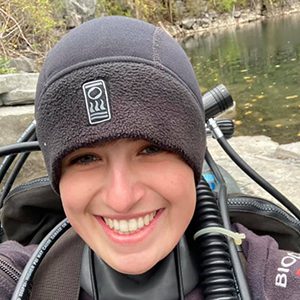
Christine Tamburri is the Risk Mitigation Coordinator at DAN. She began diving in 2016 and never looked back, spending weekend after weekend diving as much as possible while meeting industry leaders along the way. After graduating from Penn State University in 2020, she decided that a full-time job in the industry was her calling and she became a summer intern at DAN. Later that year, she was hired into her current role where she develops e-learning courses, assists first aid instructors worldwide, and designs risk assessment tools for dive operators and professionals. Christine is an avid cave and technical diver who spends every spare moment of her free time either cave diving or planning to go cave diving.
























